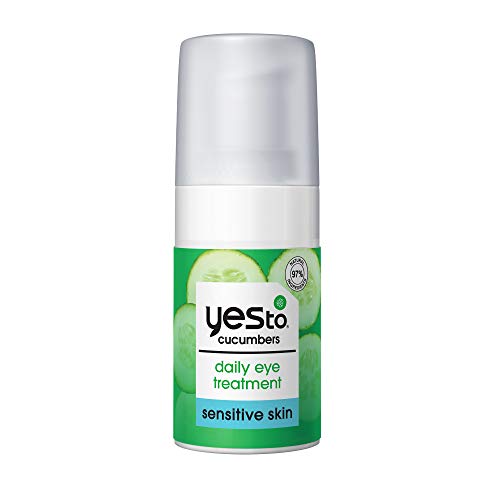
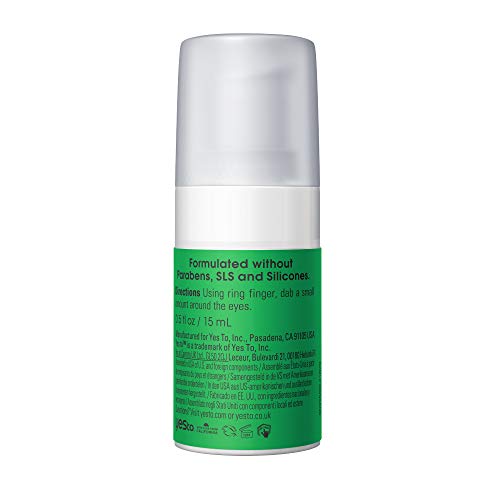
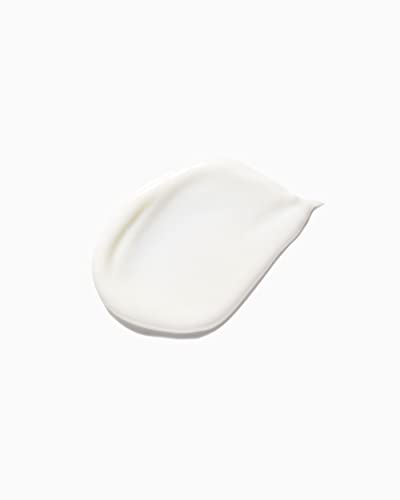
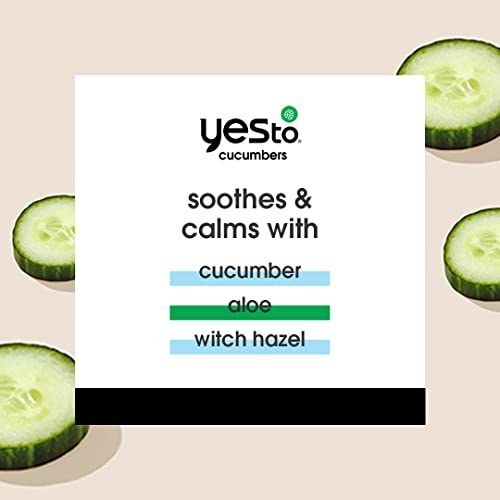
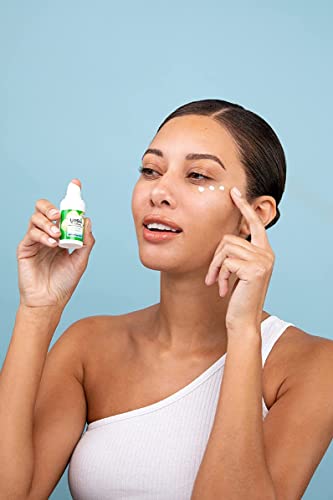
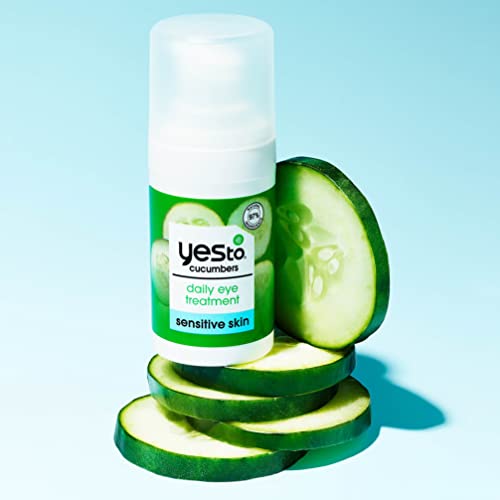
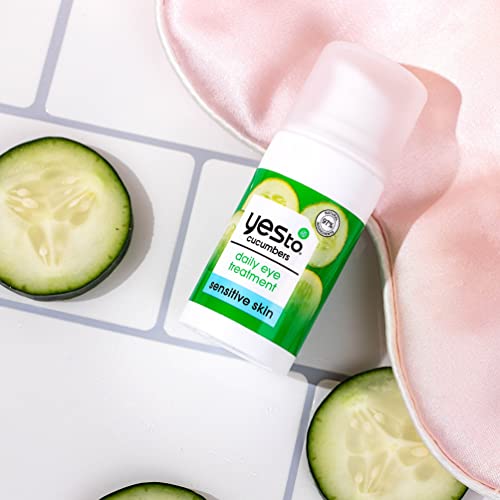

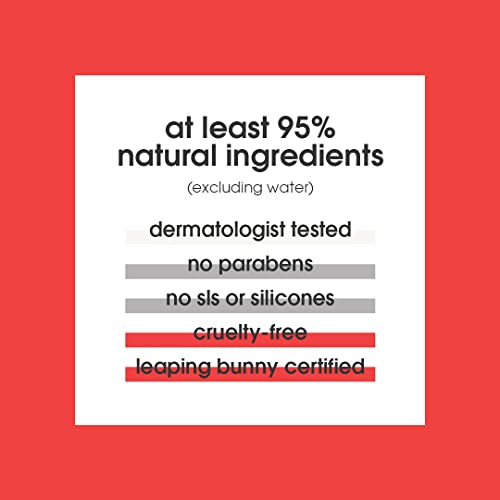
Yes To Cucumber Eye Treatment - Hydrates, Reduces Dark Circles with Natural Ingredients - 0.5 Fl Oz


Fragrance
High RiskFragrance refers to a mixture of aromatic compounds used in products to provide scent. It is commonly listed as 'fragrance' or 'parfum' on product labels and can serve various functions, including enhancing user experience and masking undesirable odors.
Sustai Insights
Fragrance offers functional benefits by improving product appeal; however, it poses significant health risks, notably a high likelihood of causing allergies and allergic contact dermatitis. Environmental risks include potential pollution and endocrine disruption, though its overall carcinogenicity is low. Regulatory bodies have noted concerns regarding its use, leading to a high-risk classification. Safe usage practices should be observed, and alternatives such as natural essential oils are recommended for those sensitive to synthetic fragrances.
Glycerin
Medium RiskGlycerin (also called glycerol) is a naturally occurring compound commonly used in personal care and cosmetic products. It functions as a humectant, attracting moisture to the skin, and is also utilized as a solvent and emollient to enhance product texture and stability.
Sustai Insights
Glycerin is valued for its effective moisturizing properties and biodegradability, making it a widely accepted ingredient in formulations. It poses low health risks, including low concerns for carcinogenicity and allergies. However, moderate use restrictions exist due to regulatory guidelines. While glycerin does not significantly contribute to environmental pollution, its production process should be ethically sourced. Overall, glycerin holds a medium risk level, emphasizing the importance of safe usage practices and considering sustainable alternatives.
Citric Acid
Medium RiskCitric acid is an alpha hydroxy acid used in personal care products primarily for its role as a pH adjuster and natural preservative. It occurs naturally in citrus fruits and is commonly utilized in various formulations for its chelating properties and mild exfoliation benefits.
Sustai Insights
Citric acid offers functional benefits as an effective preservative and pH stabilizer, contributing to product longevity and stability. It is biodegradable and derived from renewable sources. Health risks are low, with minimal concerns regarding carcinogenicity, allergies, and reproductive toxicity. However, moderate use restrictions exist due to potential irritation at high concentrations. Environmental risks are limited, as citric acid is not known to accumulate in ecosystems. Regulatory agencies have no significant advisories against its use. Overall, it is assessed as a medium-risk ingredient, with safe usage practices recommended and alternatives available.
Sodium Benzoate
Medium RiskSodium benzoate is a preservative commonly used in food and cosmetic products to prevent microbial growth and extend shelf life. It is derived from benzoic acid and is effective at low concentrations, often used in acidic environments like beverages and condiments.
Sustai Insights
Sodium benzoate serves effectively as a preservative, contributing to product stability and safety. It is generally recognized as safe with low concerns for carcinogenicity, allergies, and reproductive toxicity, though it faces moderate use restrictions in some regions. Environmental risks include its potential as a pollutant, but it does not bioaccumulate significantly. Regulatory bodies have issued advisories regarding its concentration in products. Overall, the risk level is assessed as medium, with safe usage practices recommended. Alternatives such as potassium sorbate may provide similar benefits with potentially lower restrictions.
Potassium Sorbate
Medium RiskPotassium sorbate is a potassium salt of sorbic acid, primarily used as a preservative in food and cosmetic products. It inhibits the growth of molds, yeast, and some bacteria, extending the shelf life of products. It is commonly found in various formulations due to its effectiveness and low toxicity.
Sustai Insights
Potassium sorbate serves as an effective preservative, preventing microbial growth in food and cosmetic products, which is vital for safety and longevity. Although it has a low risk of carcinogenicity and developmental toxicity, there is a moderate concern regarding allergies and immunotoxicity. Environmentally, it poses minimal risks as it is not significantly bioaccumulative. Regulatory agencies have verified its use, although some products may face restrictions. Overall, it is assessed as a medium risk ingredient, with safe usage practices recommended, and alternatives such as natural preservatives could be considered.
Sodium Stearoyl Lactylate
Low RiskSodium stearoyl lactylate is a sodium salt of stearoyl lactylic acid. It is primarily used as an emulsifier and stabilizer in various cosmetic and personal care products, enhancing texture and consistency. It is also utilized in food applications for similar purposes.
Sustai Insights
Sodium stearoyl lactylate serves as an effective emulsifier, improving product stability and texture. It is considered to have low health risks, including low potential for carcinogenicity and allergies, with minimal environmental impact. Regulatory bodies have not issued significant warnings, maintaining a low overall risk profile. Safe usage practices should be followed, and alternatives such as glyceryl stearate could be considered for those seeking different emulsifying agents.
Caffeine
Low RiskCaffeine is a heterocyclic organic compound commonly found in coffee, tea, and various other plants. It acts as a central nervous system stimulant, temporarily warding off drowsiness and restoring alertness. In cosmetic applications, it is often included for its purported benefits in enhancing skin absorption and reducing the appearance of puffiness.
Sustai Insights
Caffeine offers functional benefits such as enhancing skin absorption and providing a stimulating effect. It is generally regarded as safe with low concerns regarding carcinogenicity, allergies, or developmental toxicity. Environmental risks include potential bioaccumulation, though overall it poses low risk based on current scientific consensus. Regulatory bodies have minimal restrictions, but care should be taken regarding enhanced skin absorption. Alternatives may include other stimulants or natural extracts with similar properties. Overall, caffeine is assessed as low risk.
Candelilla/Jojoba/Rice Bran Polyglyceryl 3 Esters
Low RiskCandelilla/jojoba/rice bran polyglyceryl-3 esters is a cosmetic ingredient derived from the transesterification of candelilla wax, jojoba oil, and rice bran oil. It functions primarily as an emulsifier and skin-conditioning agent, aiding in the formulation of various cosmetic products.
Sustai Insights
This ingredient offers functional benefits as an emulsifier and skin conditioner, contributing to product stability and texture. It is derived from renewable sources, suggesting potential sustainability credentials. Health risks are minimal, with low concerns for carcinogenicity, allergies, and irritation. Environmental impacts are also low, with no significant pollutant or bioaccumulation potential. Regulatory status is largely favorable, with no significant restrictions noted. Overall risk assessment indicates low risk, making it a suitable choice in cosmetic formulations.
Methyl Glucose Sesquistearate
Low RiskMethyl glucose sesquistearate is a mixture of methyl glucose and stearic acid, primarily used as an emulsifier and skin-conditioning agent in cosmetic formulations. It helps to stabilize and thicken products, enhancing texture and application.
Sustai Insights
Methyl glucose sesquistearate offers functional benefits as an effective emulsifier, promoting stability in formulations. It is considered low risk for health impacts, with minimal concerns regarding carcinogenicity, allergies, or reproductive toxicity. Environmentally, it poses low risks, not being a pollutant or bioaccumulative. Regulatory reviews indicate no current restrictions, supporting its safe use in cosmetics. Overall, the ingredient is regarded as low risk, with no significant adverse impacts noted. Alternative emulsifiers may include plant-based options, promoting sustainable practices.
Prunus Amygdalus Dulcis (Sweet Almond) Oil
Low RiskPrunus amygdalus dulcis (sweet almond) oil is derived from the seeds of the almond tree. It is commonly used in cosmetic formulations for its moisturizing properties and as a carrier oil for other active ingredients. Its light texture allows for easy absorption into the skin.
Sustai Insights
Sweet almond oil provides functional benefits such as effective skin hydration and enhancement of skin absorption for other compounds. It is sustainably sourced and biodegradable. Health risks are low, with minimal concerns regarding carcinogenicity, allergies, and reproductive toxicity. Environmental risks are also low, with no significant pollutant or bioaccumulation potential. Regulatory bodies currently do not impose restrictions on its use. Overall, the risk assessment indicates a low risk level, making it a safe choice in cosmetic applications.
Glyceryl Stearate Se
Low RiskGlyceryl stearate SE is a self-emulsifying ingredient commonly used in cosmetic formulations to stabilize and thicken products. It acts as an emulsifier, helping to blend oil and water components effectively, which enhances the product's texture and stability.
Sustai Insights
Glyceryl stearate SE offers functional benefits as an emulsifier, promoting stability in formulations. It is considered low risk for health concerns, including cancer, allergies, and reproductive toxicity, with no significant environmental hazards reported. Regulatory bodies have not imposed restrictions on its use. Safe usage practices suggest following recommended concentrations in products. Overall, this ingredient is assessed as low risk, with no immediate alternatives needed.
Olea Europaea (Olive) Oil
Low RiskOlea europaea (olive) oil is derived from the ripe fruit of the olive tree. It is commonly used in cosmetic formulations primarily as a moisturizer and emollient due to its nourishing properties for the skin. It also serves as a carrier oil for other ingredients in formulations.
Sustai Insights
Olea europaea (olive) oil offers numerous functional benefits, including effective moisturization and enhanced skin absorption properties, making it suitable for various cosmetic applications. It is a biodegradable ingredient, contributing to sustainability when sourced responsibly. Health risks are low, with minimal concerns regarding carcinogenicity, allergenic potential, and developmental toxicity. Environmental risks are also low, with no significant bioaccumulation or pollution potential noted. Regulatory bodies do not impose restrictions on its use. Overall, olive oil presents a low risk profile, making it a favorable choice in cosmetic products.
Beeswax
Low RiskBeeswax is the purified wax obtained from the honeycomb of honeybees. It is typically used as a thickening agent, emulsifier, or to provide structure in various cosmetic and personal care products.
Sustai Insights
Beeswax offers functional benefits as a natural emulsifier and thickening agent, contributing to product stability and texture. It is biodegradable and sustainably sourced, aligning with eco-friendly practices. Health risks are low, with minimal concerns regarding carcinogenicity, allergies, or irritation. Environmental risks are also low, with no significant pollutant or bioaccumulation issues. Regulatory bodies impose few restrictions, confirming its safety in use. Safe usage practices should be followed, and alternatives like plant-based waxes may be considered for those seeking vegan options. Overall, the risk level associated with beeswax is low.
Glycine Soja (Soybean) Oil
Low RiskGlycine soja (soybean) oil is derived from the seeds of the soybean plant and is commonly used in cosmetic formulations for its emollient properties. It functions as a moisturizer and skin conditioning agent, enhancing the texture and feel of products.
Sustai Insights
Glycine soja (soybean) oil offers functional benefits such as effective skin moisturization and conditioning. It is generally recognized as low-risk for health concerns, with minimal allergenic potential and no significant environmental hazards reported. Regulatory bodies have not imposed restrictions on its use. Overall, this ingredient is assessed as low risk, making it a suitable option for various cosmetic applications.
Propanediol
Low RiskPropanediol is a glycol compound commonly used in cosmetic and personal care products as a solvent, humectant, and skin-conditioning agent. It serves to enhance the texture and moisture retention of formulations, contributing to overall product efficacy.
Sustai Insights
Propanediol offers functional benefits such as effective moisture retention and improved product application. It is considered low-risk in terms of health concerns, with minimal associations with carcinogenicity, allergies, or reproductive toxicity. Environmentally, it has low pollutant potential and is not bioaccumulative. Regulatory bodies have not placed restrictions on its use. Despite concerns regarding enhanced skin absorption and potential endocrine disruption, the overall assessment indicates low risk. Safe usage practices should be followed, and alternatives like glycerin or other plant-based humectants can be considered.
Evodia Rutaecarpa Fruit Extract
Low RiskEvodia rutaecarpa fruit extract is an extract derived from the fruit of the Evodia rutaecarpa plant, used primarily for its potential therapeutic properties in various products. It is known for its application in traditional medicine and may serve as a natural ingredient in cosmetic formulations.
Sustai Insights
Evodia rutaecarpa fruit extract exhibits functional benefits, including potential anti-inflammatory and antioxidant properties. It is not associated with significant health risks, as concerns related to carcinogenicity, allergies, and reproductive toxicity are low. Environmentally, it does not contribute significantly to pollution or bioaccumulation. Regulatory status is clear, with no current restrictions, affirming its safe use. Overall, it presents a low risk profile for consumers. Safe usage practices should be followed, and potential alternatives include other natural extracts with similar benefits.
Cucumis Sativus (Cucumber) Fruit Extract
Low RiskCucumis sativus (cucumber) fruit extract is derived from the fruit of the cucumber plant. It is commonly used in cosmetic formulations for its hydrating and soothing properties, often included in products aimed at providing moisture and calming effects to the skin.
Sustai Insights
Cucumis sativus fruit extract offers functional benefits such as hydration and soothing effects on the skin, contributing to the overall efficacy of cosmetic products. It is regarded as low risk with minimal health concerns, including low potential for carcinogenicity, irritation, or allergies. Environmental risks are also low, with no significant pollutant or bioaccumulation concerns. Regulatory bodies do not impose restrictions on its use, supporting its safety in cosmetics. Safe usage practices include ensuring proper formulation concentrations. Overall, this ingredient presents a low risk profile, making it a suitable choice for various cosmetic applications.
Water
Low RiskWater is a clear, colorless liquid essential for various biological processes. It serves as a solvent in formulations, facilitating the dissolution of other ingredients and enhancing product texture and application. Additionally, water plays a crucial role in hydration and is a key component in many cosmetic and personal care products.
Sustai Insights
Water is an effective solvent and hydrator, contributing to the texture and efficacy of formulations. It is biodegradable and generally regarded as safe, with low concerns regarding carcinogenicity, allergies, and reproductive toxicity. However, excessive water usage can lead to environmental concerns, particularly regarding resource depletion. Regulatory bodies do not impose restrictions on water use in cosmetics. Overall, the risks associated with water are low, making it a safe and essential ingredient.
Xanthan Gum
Low RiskXanthan gum is a polysaccharide, a sugar-based compound produced by the fermentation of glucose or sucrose. It is commonly used as a thickening agent and stabilizer in various food and cosmetic products due to its ability to improve texture and prevent ingredient separation.
Sustai Insights
Xanthan gum serves effectively as a thickener and stabilizer, enhancing product texture and consistency. It is biodegradable and typically derived from renewable sources, supporting sustainability efforts. Health risks are minimal, with low concerns regarding carcinogenicity, allergies, and reproductive toxicity. Environmental impact is similarly low, posing no significant hazards. Regulatory agencies, including the FDA, regard it as safe for use, with no significant restrictions. Overall, xanthan gum is assessed as low risk, making it a suitable ingredient in formulations.
Cetearyl Alcohol
Low RiskCetearyl alcohol is a mixture of cetyl and stearyl alcohol, primarily used as an emulsifier and thickener in cosmetic formulations. It helps stabilize products, improve texture, and enhance moisturizing properties, making it common in creams and lotions.
Sustai Insights
Cetearyl alcohol offers functional benefits as an effective emulsifier and skin-conditioning agent, contributing to product stability and texture. It is generally recognized as safe, with low concerns for carcinogenicity, allergies, or reproductive toxicity. Environmental risks are minimal, as it is biodegradable and has low pollutant potential. Regulatory bodies have not imposed significant restrictions on its use. Overall, cetearyl alcohol is assessed to carry low risk, making it a suitable ingredient choice in cosmetic products.
Glyceryl Monostearate
Low RiskGlyceryl monostearate is a monoester of glycerol and stearic acid, commonly used as an emulsifier and stabilizer in food and cosmetic products. It helps blend oil and water-based ingredients, improving product texture and consistency.
Sustai Insights
Glyceryl monostearate offers functional benefits as an effective emulsifier, enhancing product stability and texture. It is derived from natural sources and is considered biodegradable. Health risks associated with it are low, as it shows no significant carcinogenic, allergenic, or reproductive toxicity effects. Environmental concerns are minimal, with no known pollutant or bioaccumulation issues. Regulatory bodies have not restricted its use, and it is generally regarded as safe. Overall, glyceryl monostearate presents a low risk profile, making it a suitable ingredient in various applications.
Cocos Nucifera (Coconut) Oil
Low RiskCocos Nucifera (Coconut) Oil is derived from the kernels of the coconut palm. It is primarily used in cosmetic formulations for its emollient and moisturizing properties, making it suitable for skin and hair care products.
Sustai Insights
Coconut oil serves as an effective moisturizer and emollient, promoting skin hydration and softness. It is sustainably sourced and biodegradable. Health risks are minimal, with low concerns regarding carcinogenicity, allergens, and reproductive toxicity. Environmental impact is also low, as it does not contribute significantly to pollution or bioaccumulation. Regulatory bodies have not issued restrictions on its use. Overall, coconut oil presents a low risk for health and environmental concerns, making it a safe ingredient in cosmetic products.
Butyrospermum Parkii (Shea) Butter
Low RiskButyrospermum parkii (shea) butter is a vegetable fat derived from the nuts of the shea tree. It is commonly used in cosmetic formulations for its emollient properties, providing moisture and improving skin texture. Additionally, shea butter is known for its ability to enhance the stability of products and deliver a creamy texture.
Sustai Insights
Shea butter offers functional benefits as an effective moisturizer, enhancing skin barrier function and texture. It is sustainably sourced and biodegradable, contributing to eco-friendliness. Health-wise, it is associated with low risks for carcinogenicity, allergies, and reproductive toxicity. Environmental impacts are minimal, with no significant pollutant potential identified. Regulatory assessments indicate no current restrictions. Overall, the ingredient presents a low risk, making it a favorable choice in cosmetic formulations.
Helianthus Annuus (Sunflower) Seed Oil
Low RiskHelianthus annuus (sunflower) seed oil is derived from the seeds of the sunflower plant. It serves primarily as an emollient and moisturizer in cosmetic formulations, helping to maintain skin hydration and improve texture.
Sustai Insights
Sunflower seed oil is effective as an emollient, providing moisture and improving skin texture while being biodegradable and sustainably sourced. It poses low health risks, including negligible concerns for carcinogenicity, allergies, or reproductive toxicity. Environmentally, it does not significantly contribute to pollution or bioaccumulation. Regulatory bodies currently do not list any advisories for this ingredient. Overall, it is assessed as low risk, with safe usage practices recommended. Alternatives include oils like jojoba or almond oil for those seeking different properties.
Simmondsia Chinensis (Jojoba) Seed Oil
Low RiskSimmondsia chinensis (jojoba) seed oil is extracted from the seeds of the jojoba plant. It is commonly used in cosmetics for its moisturizing properties and ability to mimic human sebum, making it beneficial for skin and hair care formulations.
Sustai Insights
Jojoba seed oil offers functional benefits such as effective moisturization and emollience, contributing to skin hydration and smoothness. It is sustainably sourced and biodegradable. Health risks are low, with minimal concerns regarding carcinogenicity, allergies, and reproductive toxicity. Environmental risks are also low, as it does not significantly contribute to pollution or bioaccumulation. Currently, there are no regulatory restrictions on its use. Overall, the risk level is low, and it is considered a safe ingredient with no significant adverse effects.
Sodium Stearoyl Lactylate
Low RiskSodium stearoyl lactylate is a sodium salt of stearoyl lactylic acid. It is primarily used as an emulsifier and stabilizer in various cosmetic and personal care products, enhancing texture and consistency. It is also utilized in food applications for similar purposes.
Sustai Insights
Sodium stearoyl lactylate serves as an effective emulsifier, improving product stability and texture. It is considered to have low health risks, including low potential for carcinogenicity and allergies, with minimal environmental impact. Regulatory bodies have not issued significant warnings, maintaining a low overall risk profile. Safe usage practices should be followed, and alternatives such as glyceryl stearate could be considered for those seeking different emulsifying agents.
Caffeine
Low RiskCaffeine is a heterocyclic organic compound commonly found in coffee, tea, and various other plants. It acts as a central nervous system stimulant, temporarily warding off drowsiness and restoring alertness. In cosmetic applications, it is often included for its purported benefits in enhancing skin absorption and reducing the appearance of puffiness.
Sustai Insights
Caffeine offers functional benefits such as enhancing skin absorption and providing a stimulating effect. It is generally regarded as safe with low concerns regarding carcinogenicity, allergies, or developmental toxicity. Environmental risks include potential bioaccumulation, though overall it poses low risk based on current scientific consensus. Regulatory bodies have minimal restrictions, but care should be taken regarding enhanced skin absorption. Alternatives may include other stimulants or natural extracts with similar properties. Overall, caffeine is assessed as low risk.
Candelilla/Jojoba/Rice Bran Polyglyceryl 3 Esters
Low RiskCandelilla/jojoba/rice bran polyglyceryl-3 esters is a cosmetic ingredient derived from the transesterification of candelilla wax, jojoba oil, and rice bran oil. It functions primarily as an emulsifier and skin-conditioning agent, aiding in the formulation of various cosmetic products.
Sustai Insights
This ingredient offers functional benefits as an emulsifier and skin conditioner, contributing to product stability and texture. It is derived from renewable sources, suggesting potential sustainability credentials. Health risks are minimal, with low concerns for carcinogenicity, allergies, and irritation. Environmental impacts are also low, with no significant pollutant or bioaccumulation potential. Regulatory status is largely favorable, with no significant restrictions noted. Overall risk assessment indicates low risk, making it a suitable choice in cosmetic formulations.
Methyl Glucose Sesquistearate
Low RiskMethyl glucose sesquistearate is a mixture of methyl glucose and stearic acid, primarily used as an emulsifier and skin-conditioning agent in cosmetic formulations. It helps to stabilize and thicken products, enhancing texture and application.
Sustai Insights
Methyl glucose sesquistearate offers functional benefits as an effective emulsifier, promoting stability in formulations. It is considered low risk for health impacts, with minimal concerns regarding carcinogenicity, allergies, or reproductive toxicity. Environmentally, it poses low risks, not being a pollutant or bioaccumulative. Regulatory reviews indicate no current restrictions, supporting its safe use in cosmetics. Overall, the ingredient is regarded as low risk, with no significant adverse impacts noted. Alternative emulsifiers may include plant-based options, promoting sustainable practices.
Prunus Amygdalus Dulcis (Sweet Almond) Oil
Low RiskPrunus amygdalus dulcis (sweet almond) oil is derived from the seeds of the almond tree. It is commonly used in cosmetic formulations for its moisturizing properties and as a carrier oil for other active ingredients. Its light texture allows for easy absorption into the skin.
Sustai Insights
Sweet almond oil provides functional benefits such as effective skin hydration and enhancement of skin absorption for other compounds. It is sustainably sourced and biodegradable. Health risks are low, with minimal concerns regarding carcinogenicity, allergies, and reproductive toxicity. Environmental risks are also low, with no significant pollutant or bioaccumulation potential. Regulatory bodies currently do not impose restrictions on its use. Overall, the risk assessment indicates a low risk level, making it a safe choice in cosmetic applications.
Glyceryl Stearate Se
Low RiskGlyceryl stearate SE is a self-emulsifying ingredient commonly used in cosmetic formulations to stabilize and thicken products. It acts as an emulsifier, helping to blend oil and water components effectively, which enhances the product's texture and stability.
Sustai Insights
Glyceryl stearate SE offers functional benefits as an emulsifier, promoting stability in formulations. It is considered low risk for health concerns, including cancer, allergies, and reproductive toxicity, with no significant environmental hazards reported. Regulatory bodies have not imposed restrictions on its use. Safe usage practices suggest following recommended concentrations in products. Overall, this ingredient is assessed as low risk, with no immediate alternatives needed.
Olea Europaea (Olive) Oil
Low RiskOlea europaea (olive) oil is derived from the ripe fruit of the olive tree. It is commonly used in cosmetic formulations primarily as a moisturizer and emollient due to its nourishing properties for the skin. It also serves as a carrier oil for other ingredients in formulations.
Sustai Insights
Olea europaea (olive) oil offers numerous functional benefits, including effective moisturization and enhanced skin absorption properties, making it suitable for various cosmetic applications. It is a biodegradable ingredient, contributing to sustainability when sourced responsibly. Health risks are low, with minimal concerns regarding carcinogenicity, allergenic potential, and developmental toxicity. Environmental risks are also low, with no significant bioaccumulation or pollution potential noted. Regulatory bodies do not impose restrictions on its use. Overall, olive oil presents a low risk profile, making it a favorable choice in cosmetic products.
Beeswax
Low RiskBeeswax is the purified wax obtained from the honeycomb of honeybees. It is typically used as a thickening agent, emulsifier, or to provide structure in various cosmetic and personal care products.
Sustai Insights
Beeswax offers functional benefits as a natural emulsifier and thickening agent, contributing to product stability and texture. It is biodegradable and sustainably sourced, aligning with eco-friendly practices. Health risks are low, with minimal concerns regarding carcinogenicity, allergies, or irritation. Environmental risks are also low, with no significant pollutant or bioaccumulation issues. Regulatory bodies impose few restrictions, confirming its safety in use. Safe usage practices should be followed, and alternatives like plant-based waxes may be considered for those seeking vegan options. Overall, the risk level associated with beeswax is low.
Glycine Soja (Soybean) Oil
Low RiskGlycine soja (soybean) oil is derived from the seeds of the soybean plant and is commonly used in cosmetic formulations for its emollient properties. It functions as a moisturizer and skin conditioning agent, enhancing the texture and feel of products.
Sustai Insights
Glycine soja (soybean) oil offers functional benefits such as effective skin moisturization and conditioning. It is generally recognized as low-risk for health concerns, with minimal allergenic potential and no significant environmental hazards reported. Regulatory bodies have not imposed restrictions on its use. Overall, this ingredient is assessed as low risk, making it a suitable option for various cosmetic applications.
Propanediol
Low RiskPropanediol is a glycol compound commonly used in cosmetic and personal care products as a solvent, humectant, and skin-conditioning agent. It serves to enhance the texture and moisture retention of formulations, contributing to overall product efficacy.
Sustai Insights
Propanediol offers functional benefits such as effective moisture retention and improved product application. It is considered low-risk in terms of health concerns, with minimal associations with carcinogenicity, allergies, or reproductive toxicity. Environmentally, it has low pollutant potential and is not bioaccumulative. Regulatory bodies have not placed restrictions on its use. Despite concerns regarding enhanced skin absorption and potential endocrine disruption, the overall assessment indicates low risk. Safe usage practices should be followed, and alternatives like glycerin or other plant-based humectants can be considered.
Evodia Rutaecarpa Fruit Extract
Low RiskEvodia rutaecarpa fruit extract is an extract derived from the fruit of the Evodia rutaecarpa plant, used primarily for its potential therapeutic properties in various products. It is known for its application in traditional medicine and may serve as a natural ingredient in cosmetic formulations.
Sustai Insights
Evodia rutaecarpa fruit extract exhibits functional benefits, including potential anti-inflammatory and antioxidant properties. It is not associated with significant health risks, as concerns related to carcinogenicity, allergies, and reproductive toxicity are low. Environmentally, it does not contribute significantly to pollution or bioaccumulation. Regulatory status is clear, with no current restrictions, affirming its safe use. Overall, it presents a low risk profile for consumers. Safe usage practices should be followed, and potential alternatives include other natural extracts with similar benefits.
Cucumis Sativus (Cucumber) Fruit Extract
Low RiskCucumis sativus (cucumber) fruit extract is derived from the fruit of the cucumber plant. It is commonly used in cosmetic formulations for its hydrating and soothing properties, often included in products aimed at providing moisture and calming effects to the skin.
Sustai Insights
Cucumis sativus fruit extract offers functional benefits such as hydration and soothing effects on the skin, contributing to the overall efficacy of cosmetic products. It is regarded as low risk with minimal health concerns, including low potential for carcinogenicity, irritation, or allergies. Environmental risks are also low, with no significant pollutant or bioaccumulation concerns. Regulatory bodies do not impose restrictions on its use, supporting its safety in cosmetics. Safe usage practices include ensuring proper formulation concentrations. Overall, this ingredient presents a low risk profile, making it a suitable choice for various cosmetic applications.
Water
Low RiskWater is a clear, colorless liquid essential for various biological processes. It serves as a solvent in formulations, facilitating the dissolution of other ingredients and enhancing product texture and application. Additionally, water plays a crucial role in hydration and is a key component in many cosmetic and personal care products.
Sustai Insights
Water is an effective solvent and hydrator, contributing to the texture and efficacy of formulations. It is biodegradable and generally regarded as safe, with low concerns regarding carcinogenicity, allergies, and reproductive toxicity. However, excessive water usage can lead to environmental concerns, particularly regarding resource depletion. Regulatory bodies do not impose restrictions on water use in cosmetics. Overall, the risks associated with water are low, making it a safe and essential ingredient.
Glycerin
Medium RiskGlycerin (also called glycerol) is a naturally occurring compound commonly used in personal care and cosmetic products. It functions as a humectant, attracting moisture to the skin, and is also utilized as a solvent and emollient to enhance product texture and stability.
Sustai Insights
Glycerin is valued for its effective moisturizing properties and biodegradability, making it a widely accepted ingredient in formulations. It poses low health risks, including low concerns for carcinogenicity and allergies. However, moderate use restrictions exist due to regulatory guidelines. While glycerin does not significantly contribute to environmental pollution, its production process should be ethically sourced. Overall, glycerin holds a medium risk level, emphasizing the importance of safe usage practices and considering sustainable alternatives.
Fragrance
High RiskFragrance refers to a mixture of aromatic compounds used in products to provide scent. It is commonly listed as 'fragrance' or 'parfum' on product labels and can serve various functions, including enhancing user experience and masking undesirable odors.
Sustai Insights
Fragrance offers functional benefits by improving product appeal; however, it poses significant health risks, notably a high likelihood of causing allergies and allergic contact dermatitis. Environmental risks include potential pollution and endocrine disruption, though its overall carcinogenicity is low. Regulatory bodies have noted concerns regarding its use, leading to a high-risk classification. Safe usage practices should be observed, and alternatives such as natural essential oils are recommended for those sensitive to synthetic fragrances.
Citric Acid
Medium RiskCitric acid is an alpha hydroxy acid used in personal care products primarily for its role as a pH adjuster and natural preservative. It occurs naturally in citrus fruits and is commonly utilized in various formulations for its chelating properties and mild exfoliation benefits.
Sustai Insights
Citric acid offers functional benefits as an effective preservative and pH stabilizer, contributing to product longevity and stability. It is biodegradable and derived from renewable sources. Health risks are low, with minimal concerns regarding carcinogenicity, allergies, and reproductive toxicity. However, moderate use restrictions exist due to potential irritation at high concentrations. Environmental risks are limited, as citric acid is not known to accumulate in ecosystems. Regulatory agencies have no significant advisories against its use. Overall, it is assessed as a medium-risk ingredient, with safe usage practices recommended and alternatives available.
Xanthan Gum
Low RiskXanthan gum is a polysaccharide, a sugar-based compound produced by the fermentation of glucose or sucrose. It is commonly used as a thickening agent and stabilizer in various food and cosmetic products due to its ability to improve texture and prevent ingredient separation.
Sustai Insights
Xanthan gum serves effectively as a thickener and stabilizer, enhancing product texture and consistency. It is biodegradable and typically derived from renewable sources, supporting sustainability efforts. Health risks are minimal, with low concerns regarding carcinogenicity, allergies, and reproductive toxicity. Environmental impact is similarly low, posing no significant hazards. Regulatory agencies, including the FDA, regard it as safe for use, with no significant restrictions. Overall, xanthan gum is assessed as low risk, making it a suitable ingredient in formulations.
Sodium Benzoate
Medium RiskSodium benzoate is a preservative commonly used in food and cosmetic products to prevent microbial growth and extend shelf life. It is derived from benzoic acid and is effective at low concentrations, often used in acidic environments like beverages and condiments.
Sustai Insights
Sodium benzoate serves effectively as a preservative, contributing to product stability and safety. It is generally recognized as safe with low concerns for carcinogenicity, allergies, and reproductive toxicity, though it faces moderate use restrictions in some regions. Environmental risks include its potential as a pollutant, but it does not bioaccumulate significantly. Regulatory bodies have issued advisories regarding its concentration in products. Overall, the risk level is assessed as medium, with safe usage practices recommended. Alternatives such as potassium sorbate may provide similar benefits with potentially lower restrictions.
Cetearyl Alcohol
Low RiskCetearyl alcohol is a mixture of cetyl and stearyl alcohol, primarily used as an emulsifier and thickener in cosmetic formulations. It helps stabilize products, improve texture, and enhance moisturizing properties, making it common in creams and lotions.
Sustai Insights
Cetearyl alcohol offers functional benefits as an effective emulsifier and skin-conditioning agent, contributing to product stability and texture. It is generally recognized as safe, with low concerns for carcinogenicity, allergies, or reproductive toxicity. Environmental risks are minimal, as it is biodegradable and has low pollutant potential. Regulatory bodies have not imposed significant restrictions on its use. Overall, cetearyl alcohol is assessed to carry low risk, making it a suitable ingredient choice in cosmetic products.
Potassium Sorbate
Medium RiskPotassium sorbate is a potassium salt of sorbic acid, primarily used as a preservative in food and cosmetic products. It inhibits the growth of molds, yeast, and some bacteria, extending the shelf life of products. It is commonly found in various formulations due to its effectiveness and low toxicity.
Sustai Insights
Potassium sorbate serves as an effective preservative, preventing microbial growth in food and cosmetic products, which is vital for safety and longevity. Although it has a low risk of carcinogenicity and developmental toxicity, there is a moderate concern regarding allergies and immunotoxicity. Environmentally, it poses minimal risks as it is not significantly bioaccumulative. Regulatory agencies have verified its use, although some products may face restrictions. Overall, it is assessed as a medium risk ingredient, with safe usage practices recommended, and alternatives such as natural preservatives could be considered.
Glyceryl Monostearate
Low RiskGlyceryl monostearate is a monoester of glycerol and stearic acid, commonly used as an emulsifier and stabilizer in food and cosmetic products. It helps blend oil and water-based ingredients, improving product texture and consistency.
Sustai Insights
Glyceryl monostearate offers functional benefits as an effective emulsifier, enhancing product stability and texture. It is derived from natural sources and is considered biodegradable. Health risks associated with it are low, as it shows no significant carcinogenic, allergenic, or reproductive toxicity effects. Environmental concerns are minimal, with no known pollutant or bioaccumulation issues. Regulatory bodies have not restricted its use, and it is generally regarded as safe. Overall, glyceryl monostearate presents a low risk profile, making it a suitable ingredient in various applications.
Cocos Nucifera (Coconut) Oil
Low RiskCocos Nucifera (Coconut) Oil is derived from the kernels of the coconut palm. It is primarily used in cosmetic formulations for its emollient and moisturizing properties, making it suitable for skin and hair care products.
Sustai Insights
Coconut oil serves as an effective moisturizer and emollient, promoting skin hydration and softness. It is sustainably sourced and biodegradable. Health risks are minimal, with low concerns regarding carcinogenicity, allergens, and reproductive toxicity. Environmental impact is also low, as it does not contribute significantly to pollution or bioaccumulation. Regulatory bodies have not issued restrictions on its use. Overall, coconut oil presents a low risk for health and environmental concerns, making it a safe ingredient in cosmetic products.
Butyrospermum Parkii (Shea) Butter
Low RiskButyrospermum parkii (shea) butter is a vegetable fat derived from the nuts of the shea tree. It is commonly used in cosmetic formulations for its emollient properties, providing moisture and improving skin texture. Additionally, shea butter is known for its ability to enhance the stability of products and deliver a creamy texture.
Sustai Insights
Shea butter offers functional benefits as an effective moisturizer, enhancing skin barrier function and texture. It is sustainably sourced and biodegradable, contributing to eco-friendliness. Health-wise, it is associated with low risks for carcinogenicity, allergies, and reproductive toxicity. Environmental impacts are minimal, with no significant pollutant potential identified. Regulatory assessments indicate no current restrictions. Overall, the ingredient presents a low risk, making it a favorable choice in cosmetic formulations.
Helianthus Annuus (Sunflower) Seed Oil
Low RiskHelianthus annuus (sunflower) seed oil is derived from the seeds of the sunflower plant. It serves primarily as an emollient and moisturizer in cosmetic formulations, helping to maintain skin hydration and improve texture.
Sustai Insights
Sunflower seed oil is effective as an emollient, providing moisture and improving skin texture while being biodegradable and sustainably sourced. It poses low health risks, including negligible concerns for carcinogenicity, allergies, or reproductive toxicity. Environmentally, it does not significantly contribute to pollution or bioaccumulation. Regulatory bodies currently do not list any advisories for this ingredient. Overall, it is assessed as low risk, with safe usage practices recommended. Alternatives include oils like jojoba or almond oil for those seeking different properties.
Simmondsia Chinensis (Jojoba) Seed Oil
Low RiskSimmondsia chinensis (jojoba) seed oil is extracted from the seeds of the jojoba plant. It is commonly used in cosmetics for its moisturizing properties and ability to mimic human sebum, making it beneficial for skin and hair care formulations.
Sustai Insights
Jojoba seed oil offers functional benefits such as effective moisturization and emollience, contributing to skin hydration and smoothness. It is sustainably sourced and biodegradable. Health risks are low, with minimal concerns regarding carcinogenicity, allergies, and reproductive toxicity. Environmental risks are also low, as it does not significantly contribute to pollution or bioaccumulation. Currently, there are no regulatory restrictions on its use. Overall, the risk level is low, and it is considered a safe ingredient with no significant adverse effects.
Discover the soothing benefits of Yes To Cucumber Daily Eye Treatment, a moisturizing and quick-absorbing formula designed to refresh under-eye skin. Perfect for sensitive skin, this eye treatment combines natural ingredients like cucumber extract and caffeine to de-puff and hydrate, leaving your eyes looking bright and revitalized.
- Minimizes Dark Circles: Dermatologist-tested to help reduce the appearance of dark circles, making tired eyes look alert.
- Gentle on Sensitive Skin: This creamy treatment glides on smoothly, soothing delicate skin around the eyes without irritation.
- Natural Ingredients: Over 95% of this product is made from natural ingredients, free from parabens, SLS, and silicones, ensuring a safe choice for your skincare routine.
- Cruelty-Free Assurance: Leaping Bunny certified, affirming no testing on animals, empowering you to choose ethically produced skincare.
- Easy Application: Use morning and night after cleansing for optimal hydration; pair with an under-eye mask for an extra cooling effect.
Elevate your skincare routine with a product that cares for your skin and the planet.
Subscribe & Save with Sustai
- Best Price Guarantee: Always enjoy the lowest prices on sustainable home essentials.
- No Surprises: We’ll notify you before shipping. No hidden fees, ever.
- You’re in Charge: Change, pause, or cancel your subscription anytime with ease.
- Eco-Friendly Deliveries: Our grouped shipments mean less packaging and lower emissions.
Join us on a sustainable journey. Special offers for a limited time! Prices and promotions may change.
Recommended Products
Discover the soothing benefits of Yes To Cucumber Daily Eye Treatment, a moisturizing and quick-absorbing formula designed to refresh under-eye skin. Perfect for sensitive skin, this eye treatment combines natural ingredients like cucumber extract and caffeine to de-puff and hydrate, leaving your eyes looking bright and revitalized.
- Minimizes Dark Circles: Dermatologist-tested to help reduce the appearance of dark circles, making tired eyes look alert.
- Gentle on Sensitive Skin: This creamy treatment glides on smoothly, soothing delicate skin around the eyes without irritation.
- Natural Ingredients: Over 95% of this product is made from natural ingredients, free from parabens, SLS, and silicones, ensuring a safe choice for your skincare routine.
- Cruelty-Free Assurance: Leaping Bunny certified, affirming no testing on animals, empowering you to choose ethically produced skincare.
- Easy Application: Use morning and night after cleansing for optimal hydration; pair with an under-eye mask for an extra cooling effect.
Elevate your skincare routine with a product that cares for your skin and the planet.

You can have at most 2 Sustainable Steals products in your cart
Customer Reviews
Customers’ View
Customers appreciate the soothing and hydrating effects of the Eye Treatment, noting how it refreshingly cools the eye area and provides effective moisture. Many users highlight the product's lightweight and gentle formula, making it suitable for sensitive skin, with comments such as, "It truly moisturizes the eye area" and "I love the refreshing feeling underneath my eyes." Additionally, customers value the natural composition, with over 95% of ingredients being natural and cruelty-free, aligning with environmentally conscious choices. However, opinions vary regarding the product's irritancy and scent, with some experiencing sensitivity or dissatisfaction with certain batches. Overall, customers find this eye treatment effective, making it a relevant choice for those seeking a health-conscious skincare option.
AI-generated from the text of customer reviewsThis product is rated 4.6 of 5.0 stars.
It has received 7 reviews.




